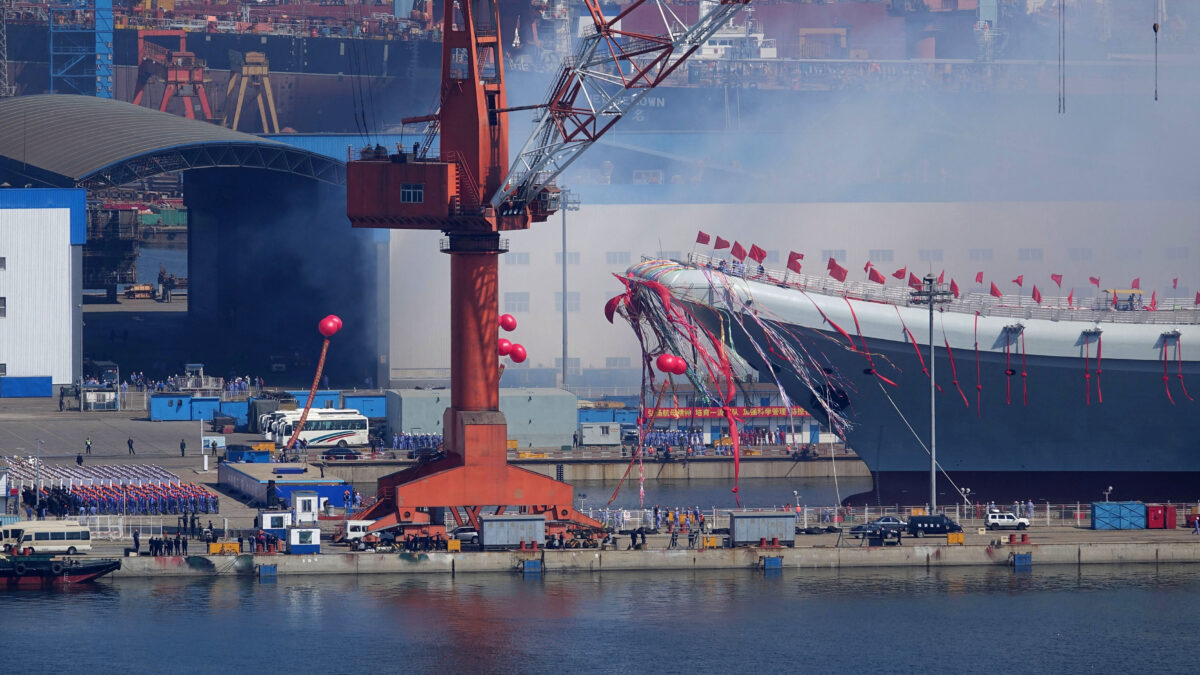Commentary
President Joe Biden spoke with Chinese leader Xi Jinping on the phone last week. Biden’s stated objective: To establish “guardrails” for the U.S.–China relationship in order to ensure the competition between the two nations doesn’t veer into outright conflict or a shooting war.
That sounds good, but it assumes that Beijing sees itself as simply being in “competition” with Washington—rather than already being engaged in a multi-front, multi-discipline war against the United States. In fact, Biden’s claim that the United States is just competing with China is a de facto win for Xi on one of the battlefields—psychological warfare.
Go down the list of other battlefields and it sure looks like war. All that’s missing is the shooting.
The Deadly Political Warfare Battlefield
Beijing has a longstanding global political warfare campaign that subverts governments and elites worldwide. That campaign pays off in nations that are politically aligned with Beijing against the United States—or at least staying neutral—and acts to isolate and punish countries inclined to resist China. Outcomes include political and economic subservience and eventual Chinese military access.
China is fighting this war on all geographical fronts. It’s active in Latin America, the Caribbean, Africa, Southeast Asia, the South Pacific, and even has its sights on the Arctic—with China declaring itself to be a “near-Arctic nation” even though the concept doesn’t exist in international law. Antarctica, and its strategic positioning and resources, is similarly in the crosshairs.
The idea is to put the Americans (and its dwindling number of allies) in a position where they can’t move—or at least not at an acceptable cost. If so, the game is over before the Americans figure out that the competition is in fact a war. In other words, “winning without fighting.”

There’s a range of battlefields in the larger political warfare assault:
Bio-war: We’re two years into it. At a minimum, Beijing opportunistically seeded the virus that caused the COVID-19 pandemic while pleading innocence and blocking investigations that could have saved lives and competing economies. Next time, it will have worked out the kinks.
Civil war: Beijing stokes internal conflict inside the United States in part via mass customized manipulation through social media. Not that it has to try very hard. What’s better than an enemy that’s fighting with itself?
Drug war: Most fentanyl originates in China—and more than 60,000 Americans died in 2020 from fentanyl overdose. That’s more than the number of American soldiers killed in the entire Vietnam War.
Economic war: China purchased key U.S. companies by the hundreds over the past few decades and obtained critical U.S. technologies by hook and by crook. It also got U.S. businesses (egged on by Wall Street) to move enough manufacturing to China over the past 30 years, leaving large swaths of the United States gutted and the inhabitants stunned, despairing, and too often drug-addicted—on China-sourced fentanyl.
And in a gradual, preemptive act of surrender, U.S. companies have set up supply chains for key materials and products—such as pharmaceuticals—in China.
Beijing is also buttressing its economic defenses—which is a standard operating procedure for a country at war—in part by making itself “sanctions proof” (the modern economic equivalent of siege-proof).
Trade war: We’re two decades into this front of the economic war. Washington gave China the go-ahead to attack in 2001 when it let the People’s Republic of China (PRC) into the World Trade Organization (WTO)—despite not meeting qualifications. It didn’t take a strategic genius to know what would happen. Even before that, Beijing was aggressively violating General Agreement on Tariffs and Trade regulations as a matter of national policy.

Financial war: The PRC is trying to displace the U.S. dollar as the world’s reserve currency. The dollar is America’s last solid means of applying pressure against Beijing. Yet the Biden administration and previous administrations have done their best to debase the currency. If the Chinese regime makes enough progress on that front, the United States won’t even be able to fund its own defense.
Kinetic War
While forging ahead with weakening the defenses of its opponents through political warfare, Beijing is also preparing and positioning for a “traditional” kinetic—or shooting—war.
To the Chinese regime, political warfare and kinetic warfare are part of the same continuum, and it will transition from one to the other as needed to achieve its goals. Just ask Tibet, Vietnam, India, or others that it has attacked over the years.
The U.S. military’s top dogs are once again dying to engage with the People’s Liberation Army (PLA), even as Chinese officers are dying to engage with the Americans—though in a different way. Some examples include the following:
Military size, capability, and reach: The Chinese regime has undertaken the largest and fastest defense build-up since World War II and probably in history. It’s dramatically expanding its size, capabilities, and reach. The PLA is already a match for U.S. forces in certain circumstances.
The Chinese Navy’s fleet is larger than the U.S. Navy, and China is producing hypersonic and aircraft carrier killer missiles. It’s rapidly improving undersea warfare capabilities as well.
In terms of power projection, the regime is seizing maritime territory, including its building of artificial islands in the South China Sea and turning them into military bases to dominate the zone and expand the PLA’s operational reach.
Beijing is also setting up port and airfield access worldwide. It started with commercial inroads, but aims for an eventual military presence. Djibouti was just the beginning. The Belt and Road Initiative is essentially the largest potentially dual-use infrastructure endeavor that the world has ever seen.
Outer space warfare: China is gearing up to be a “galactic hegemon”—to include strategic lunar positioning and anti-satellite weapons to destroy U.S. satellites and blind U.S. forces.
Cyberwarfare: The PRC has already gone to work, looting U.S. government and private industry networks of strategic data (including biometrics) and sector-dominating trade secrets. Yet, it has escaped almost entirely unscathed, even though the Americans know who did it.
Nuclear war: The PLA is building a nuclear weapons arsenal that will surpass the U.S. arsenal by 2025—and Russia’s, too.

Is This Normal?
That’s all breathtaking in its scope and one must admire the Chinese regime’s consistent clarity on its objective.
But isn’t China just doing what all “great powers” do?
Only if that “great power” is rapacious and looking to dominate and control its neighborhood and the rest of the globe. And how a government treats its own citizens—repressively, in China’s case—gives one a pretty good idea of how it will treat everyone else.
And keep in mind that Beijing has done all of this—positioning itself to win a shooting war or a war without shooting—despite facing no enemies. Nobody and no nation anywhere has called for attacking China.
The United States and the free world have bent over backward to welcome China into civilized society. The WTO is a case in point, along with the U.S. military’s decades of eagerness to “engage” with the PLA. Even President Ronald Reagan provided advanced military technologies to the PRC.
Successive presidents—until Donald Trump—all placated Beijing while overlooking Chinese aggressiveness and misbehavior and ignoring human rights abuses and the total absence of “rights” of any sort, including the rule of law, in China.
All of that was done with the idea that China would liberalize and become a so-called responsible stakeholder.
But while the Americans offered the open hand (and wallet) of friendship, Beijing quietly—but openly—went to war.
Some Americans did notice what China was up to but they were ignored, ridiculed, fired, or ostracized.
Others tried to raise the alarm as well—a closer proximity to China helps one see things better.
Some Indians have been warning the Americans for years—pointing out that India has been at war with China since 1962.
The Japanese military has also tried to warn its U.S. counterparts, though they were usually politely ignored or even rudely dismissed in some cases.
But ultimately, it was because America’s ruling elite class was too arrogant to see what was going on and even now can’t quite believe it—or simply wants Chinese cash.
To believe that everything the Chinese Communist Party has done is just coincidence, and not malevolent, requires a belief that the Chinese can’t think coherently or plan for the future. Rather, that they just act on impulse and have no short-term memory.
In spite of all the battlefields described above, some still say that with just a little more talking or engagement, China will come around. One can’t blame the Chinese for playing to U.S. gullibility and corruptibility. It’s political warfare 101.
The Trump administration understood that the “war” was already underway and tried to change course. They didn’t have enough time.
One hopes that Team Biden figures out that China is at war with the United States—not merely “competing”—and that whatever “guardrails” China agrees to are more likely ones that Beijing thinks will constrain Washington while it forges ahead unimpeded.
Competing is what rival rental car and soft drink companies do. It can even be what democracies do.
But the regime running China is neither a democracy nor a rental car company.
It’s out for blood.
The Article was originally published by The Epoch Times
Grant Newsham is a retired U.S. Marine officer and a former U.S. diplomat and business executive who lived and worked for many years in the Asia/Pacific region. He served as a reserve head of intelligence for Marine Forces Pacific, and was the U.S. Marine attaché, U.S. Embassy Tokyo on two occasions. He is a senior fellow with the Center for Security Policy.


